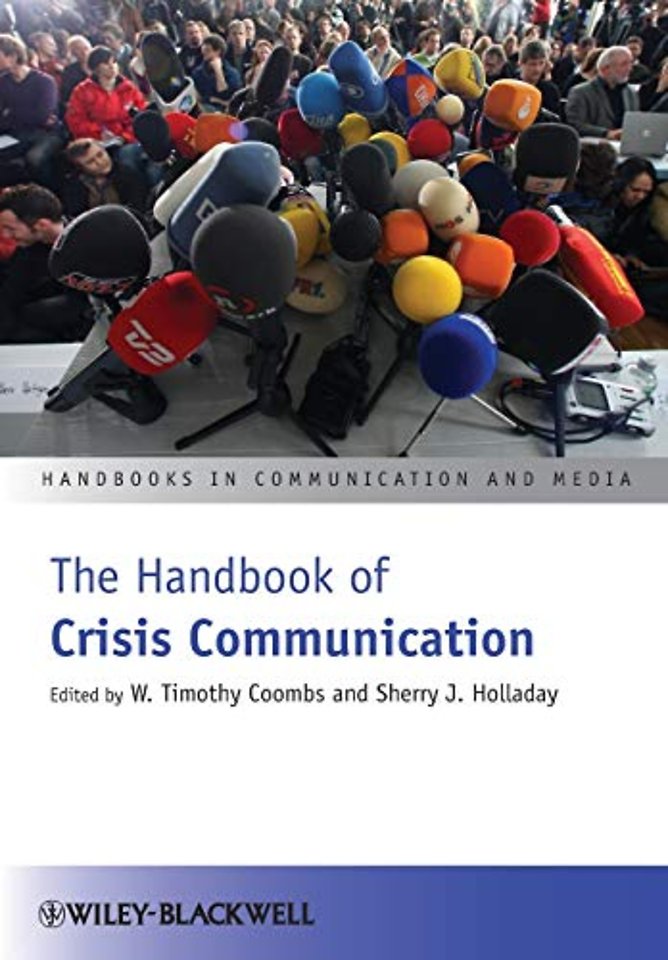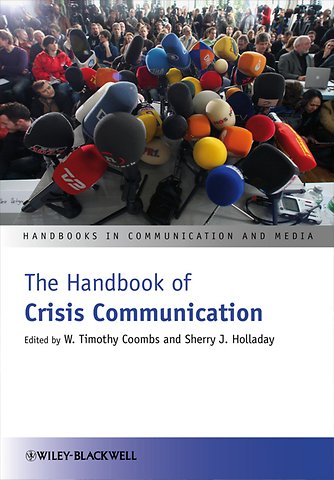The Handbook of Crisis Communication
Paperback Engels 2011 9781444361902Samenvatting
Written as a tool for both researchers and communication managers, the
Handbook of Crisis Communication is a comprehensive examination of the latest research, methods, and critical issues in crisis communication.
Includes in–depth analyses of well–known case studies in crisis communication, from terrorist attacks to Hurricane Katrina
Explores the key emerging areas of new technology and global crisis communication
Provides a starting point for developing crisis communication as a distinctive field research rather than as a sub–discipline of public relations or corporate communication
Specificaties
Lezersrecensies
Inhoudsopgave
<p>Preface xxvii</p>
<p>Acknowledgments xxix</p>
<p>Introduction 1<br /> Robert L. Heath</p>
<p>Part I Crisis and Allied Fields 15</p>
<p>1 Parameters for Crisis Communication 17<br /> W. Timothy Coombs</p>
<p>2 Crisis Communication and Its Allied Fields 54<br /> W. Timothy Coombs</p>
<p>3 Crisis Communication Research in Public Relations Journals: Tracking Research Trends Over Thirty Years 65<br /> Seon–Kyoung An and I–Huei Cheng</p>
<p>Part II Methodological Variety 91</p>
<p>Case Studies</p>
<p>4 Organizational Networks in Disaster Response: An Examination of the US Government Network s Efforts in Hurricane Katrina 93<br /> Gabriel L. Adkins</p>
<p>5 Regaining Altitude: A Case Analysis of the JetBlue Airways Valentine s Day 2007 Crisis 115<br /> Gregory G. Efthimiou</p>
<p>Textual Analysis</p>
<p>6 The Press as Agent of Cultural Repair: A Textual Analysis of News Coverage of the Virginia Tech Shootings 141<br /> Mohamad H. Elmasry and Vidhi Chaudhri</p>
<p>Content Analysis</p>
<p>7 Are They Practicing What We Are Preaching? An Investigation of Crisis Communication Strategies in the Media Coverage of Chemical Accidents 159<br /> Sherry J. Holladay</p>
<p>Experimental</p>
<p>8 Examining the Effects of Mutability and Framing on Perceptions of Human Error and Technical Error Crises: Implications for Situational Crisis Communication Theory 181<br /> W. Timothy Coombs and Sherry J. Holladay</p>
<p>9 How Do Past Crises Affect Publics Perceptions of Current Events? An Experiment Testing Corporate Reputation During an Adverse Event 205<br /> J. Drew Elliot</p>
<p>10 Crisis Response Effectiveness: Methodological Considerations for Advancement in Empirical Investigation into Response Impact 221<br /> Tomasz A. Fediuk, Kristin M. Pace, and Isabel C. Botero</p>
<p>Part III The Practice 243</p>
<p>11 We tell people. It s up to them to be prepared. Public Relations Practices of Local Emergency Managers 245<br /> Robert Littlefield, Katherine Rowan, Shari R. Veil, Lorraine Kisselburgh, Kimberly Beauchamp, Kathleen Vidoloff, Marie L. Dick, Theresa Russell–Loretz, Induk Kim, Angelica Ruvarac, Quian Wang, Hyunyi Cho, Toni Siriko Hoang, Bonita Neff, Teri Toles–Patkin, Rod Troester, Shama Hyder, Steven Venette, and Timothy L. Sellnow</p>
<p>12 Thirty Common Basic Elements of Crisis Management Plans: Guidelines for Handling the Acute Stage of Hard Emergencies at the Tactical Level 261<br /> Alexander G. Nikolaev</p>
<p>Part IV Specific Applications 283</p>
<p>Organizational Contexts</p>
<p>13 Oil Industry Crisis Communication 285<br /> Michelle Maresh and David E. Williams</p>
<p>14 Educational Crisis Management Practices Tentatively Embrace the New Media 301<br /> Barbara S. Gainey</p>
<p>15 FEMA and the Rhetoric of Redemption: New Directions in Crisis Communication Models for Government Agencies 319<br /> Elizabeth Johnson Avery and Ruthann W. Lariscy</p>
<p>Crisis Communication and Race</p>
<p>16 Effective Public Relations in Racially Charged Crises: Not Black or White 335<br /> Brooke Fisher Liu</p>
<p>17 Public Relations and Reputation Management in a Crisis Situation: How Denny s Restaurants Reinvigorated the Firm s Corporate Identity 359<br /> Ali M. Kanso, Steven R. Levitt, and Richard Alan Nelson</p>
<p>Part V Technology and Crisis Communication 379</p>
<p>18 New Media for Crisis Communication: Opportunities for Technical Translation, Dialogue, and Stakeholder Responses 381<br /> Keri K. Stephens and Patty Malone</p>
<p>19 Organizational and Media Use of Technology During Fraud Crises 396<br /> Christopher Caldiero, Maureen Taylor, and Lia Ungureanu</p>
<p>20 Organizational Use of New Communication Technology in Product Recall Crises 410<br /> Maureen Taylor</p>
<p>Part VI Global Crisis Communication 423</p>
<p>21 Crisis Communication, Complexity, and the Cartoon Affair: A Case Study 425<br /> Finn Frandsen and Winni Johansen</p>
<p>22 Crisis Communication and Terrorist Attacks: Framing a Response to the 2004 Madrid Bombings and 2005 London Bombings 449<br /> María José Canel and Karen Sanders</p>
<p>23 Negotiating Global Citizenship: Mattel s 2007 Recall Crisis 467<br /> Patricia A. Curtin</p>
<p>24 Celebrating Expulsions? Crisis Communication in the Swedish Migration Board 489<br /> Orla Vigsø</p>
<p>Part VII Theory Development 509</p>
<p>25 Crisis Communicators in Change: From Plans to Improvisations 511<br /> Jesper Falkheimer and Mats Heide</p>
<p>26 Contingency Theory of Strategic Conflict Management: Directions for the Practice of Crisis Communication from a Decade of Theory Development, Discovery, and Dialogue 527<br /> Augustine Pang, Yan Jin, and Glen T. Cameron</p>
<p>27 Crisis–Adaptive Public Information: A Model for Reliability in Chaos 550<br /> Suzanne Horsley</p>
<p>28 Communicating Before a Crisis: An Exploration of Bolstering, CSR, and Inoculation Practices 568<br /> Shelley Wigley and Michael Pfau</p>
<p>29 Who Suffers? The Effect of Injured Party on Attributions of Crisis Responsibility 591<br /> Sun–A Park and María E. Len–Ríos</p>
<p>30 The Dialectics of Organizational Crisis Management 607<br /> Charles Conrad, Jane Stuart Baker, Chris Cudahy, and Jennifer Willyard</p>
<p>31 Exploring Crisis from a Receiver Perspective: Understanding Stakeholder Reactions During Crisis Events 635<br /> Tomasz A. Fediuk, W. Timothy Coombs, and Isabel C. Botero</p>
<p>32 Credibility Seeking through an Interorganizational Alliance: Instigating the Fen–Phen Confrontation Crisis 657<br /> Timothy L. Sellnow, Shari R. Veil, and Renae A. Streifel</p>
<p>Part VIII Future Research Directions 675</p>
<p>33 Future Directions of Crisis Communication Research: Emotions in Crisis The Next Frontier 677<br /> Yan Jin and Augustine Pang</p>
<p>34 Complexity and Crises: A New Paradigm 683<br /> Dawn R. Gilpin and Priscilla Murphy</p>
<p>35 Considering the Future of Crisis Communication Research: Understanding the Opportunities Inherent to Crisis Events through the Discourse of Renewal 691<br /> Robert R. Ulmer, Timothy L. Sellnow, and Matthew W. Seeger</p>
<p>36 Toward a Holistic Organizational Approach to Understanding Crisis 698<br /> Maureen Taylor</p>
<p>37 What is a Public Relations Crisis ? Refocusing Crisis Research 705<br /> Michael L. Kent</p>
<p>38 Crisis and Learning 713<br /> Larsåke Larsson</p>
<p>39 Pursuing Evidence–Based Crisis Communication 719<br /> W. Timothy Coombs</p>
<p>Afterword 726</p>
<p>Name Index 728</p>
<p>Subject Index 732</p>
Anderen die dit kochten, kochten ook
Rubrieken
- advisering
- algemeen management
- coaching en trainen
- communicatie en media
- economie
- financieel management
- inkoop en logistiek
- internet en social media
- it-management / ict
- juridisch
- leiderschap
- marketing
- mens en maatschappij
- non-profit
- ondernemen
- organisatiekunde
- personal finance
- personeelsmanagement
- persoonlijke effectiviteit
- projectmanagement
- psychologie
- reclame en verkoop
- strategisch management
- verandermanagement
- werk en loopbaan







